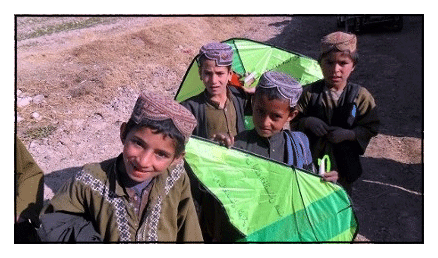Helikite - a Modern Improvement on the 'Kytoon'
The United States Army has invested time and money in a hybrid balloon-kite combination device that is designed to be a platform for low-level surveillance in areas where larger blimp-like aerostats or expensive drone aircraft are not feasible to use.
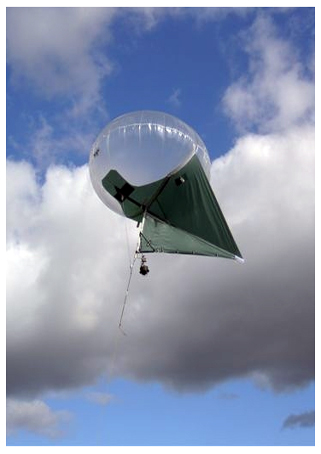 Helikite with aerial camera by Allsopp Helikites Ltd.The Stars and Stripes news service released information and photos of "Helikites," a half-kite, half-blimp aircraft for low-level surveillance. It can readily be deployed by armed forces personnel for military purposes in remote areas where air-borne surveillance cameras would be useful.
Helikite with aerial camera by Allsopp Helikites Ltd.The Stars and Stripes news service released information and photos of "Helikites," a half-kite, half-blimp aircraft for low-level surveillance. It can readily be deployed by armed forces personnel for military purposes in remote areas where air-borne surveillance cameras would be useful.
This device, which combines the properties of a blimp and a kite, and carries communications and surveillance equipment, is among the pilotless flying equipment currently being tested by the Army base at Fort Benning, Ga., Stars and Stripes reported Monday, May 20, 2012.
According to Wikipedia, the names 'Helikite' and 'Helikites', are Registered Trade Marks relating to a type of kite-style aerostat designed and patented by Sandy Allsopp in England.1
UPI.com in its May 21, 2012 story entitled Army tests blimp-kite hybrid 'Helikites', stated:
Since many of the American military bases in Afghanistan are not large enough to accommodate and maintain the large aerostats that hover over battlefields and enemy lines, sending back photos and other information, "We are looking at small, more tactical aerostats that can be used at those small bases, " said Maj. Peter Moore, product director at the Fort Benning-based Rapid Equipping Force.
The Helikite is among the small aerostats being tested to learn how long launch and recovery operations take, how they perform in windy conditions and how long training programs for operating personnel will take, the newspaper said.
Helikites range in size from a model 6 feet long capable of lifting cameras and communications equipment, to an aircraft 24 feet long that can lift as much as 30,000 pounds of equipment, said Sandy Allsopp, owner of the British firm Allsopp Helikites, which makes the aircraft for the U.S. Air Force and Navy, and the British Army.
The Allsopp Helikites have a wide variety of peace time applications as well. The devices can be used for lifting:
- Scientific instruments and equipment
- Radio antennas and radio relay or jamming equipment
- Sensors and weather instruments
- Pollution sampling equipment
- Aerial photography and video cameras
- Acoustic sensing instruments
- Thermal imaging and mine detection devices
- Remote sensing and radar arrays
- Advertising displays.
In short, anything that needs stable aerial positioning can be lofted using the Helikites.
The modern version of the aerostat-kite hybrid has a historical precedent in the work of Canadian born Domina Jalbert, inventor of both the parafoil and the 'kytoon'.
Domina Jalbert, born in Saint-Jean-de-Matha, Quebec, moved with his family to the United States where he received a pilot's license and had a deep interest in kites. Early on, Jalbert had a small advertising business using large kites.
Jalbert worked for the United States Rubber Company which built barrage balloons to help protect the coast line of the United States from attacks by enemy aircraft. Barrage balloons were large tethered aerostats that dangled metal cables that were designed to inflict damage on low-level aircraft that came into collision with the cables.
Since tethered balloons are affected by strong winds which tend to drive them lower in altitude and make them oscillate at the end of their tethers, Jalbert took his knowledge of kites and began to develop a hybrid balloon-kite device which he called a "kytoon".
Using the balloon to form the keel of a kite, Jalbert affixed kite-like wings to the keel. The effect of the wings was to both create lift when a wind was blowing and to stabilize the kytoon so that it would not wildly oscillate across the sky at the end of its tether.
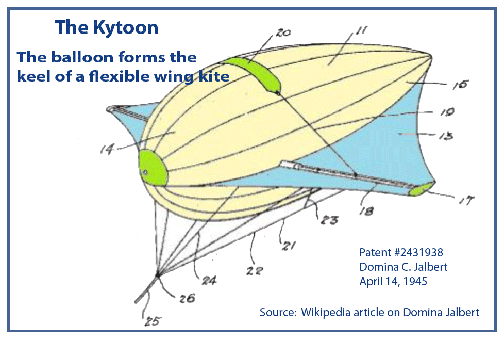 Jalbert's Patent Drawing of the Kytoon from Wikipedia.
Jalbert's Patent Drawing of the Kytoon from Wikipedia.
Jalbert's patent was filed on April 14, 1945, near the end of World War II. After the war, the kytoon did not receive much attention and it gradually drifted into obscurity. Jalbert went on to design and patent the parafoil in 1964. His contributions to kites and steerable parachutes have made him one of the great kite pioneers.
Allsopp's Helikite is a much improved hybrid aerostat-kite device over that envisioned by Jalbert back in 1945. The Helikite still embodies the concept of lift via the balloon when the air is still. It also uses the properties of the kite when the winds come up: lifting the device against the wind to ensure that the payload is sustained in its elevation and does not dart wildly from side to side on its tether.
In a May 21, 2012 posting on the Wired web site, Katie Drummond wrote an article about the Helikite entitled "Battle-Kites’ Eyed for Afghan Spy Duty". In the article she stated:
The Helikites, which are already used by the British Army, are also rather wee: The vehicles currently range in size from 6 to 24 feet in length. For comparison’s sake, consider that the Air Force’s much-contested Blue Devil 2 blimp, which might one day soar the skies above America instead of Afghanistan, measures a whopping 370 feet.
Blimps rely on helium to get them off the ground and keep them airborne. By adding a kite to the mix, the Helikite boasts an enhanced flying ability — one that’d increase its ability to haul cargo, which is likely to include plenty of surveillance gear. A 24-foot Helikite, according to its parent company, Allsopp Helikites, can lug 30,000 pounds of equipment. That’s five times the weight that aerostats of a similar size can lift. All that, and the Helikites can fly as high as 6,000 feet — keeping them safely out of range from gunfire or grenade attacks.
The military is also testing the battle-kite’s ability to help with communications in far-flung regions. A hovering battle-kite, equipped with communications gear, could offer mobile networks that’d vastly improve the sketchy wireless linkages currently available in remote realms of combat. According to the company, a Helikite elevated to 600 feet should be able to yield 113 square miles of Wi-Fi coverage.
And the Helikites, which cost an estimated $50,000 apiece, also have a key advantage over the other aerostats in the military’s array: Because they’re so small, and benefit from the wind-catching powers of a kite, they require way, way less helium.
That’s good news for the Pentagon, which is already facing potential helium shortages from keeping so many aerostats aloft. In a report issued just last year, the Defense Logistics Agency lamented that “industry cannot keep up with the increased [helium] demand” required by all those blimps.
Clearly, Allsopp's Helikite is an up-to-date device that should prove to be very useful in both military and peace time applications. Although their is similarity in concept to the historical kytoon developed by Domina Jalbert in the mid-1940's, the Helikite is clearly a superior device that is multi-functional and highly utilitarian.
It is interesting to reflect on the history of the kytoon as we appreciate the advances made with the design of the Helikite.
__________________________
Notes:
- 1From the Wikipedia article entitled Helikite.
- There is also a video of the Helikite available on the Wired.com site. It is hosted on YouTube.com
- An interesting article about the work and contributions of Canadian born kite pioneer Domina Jalbert can be found in the Popular Mechanics article He Flies Kites for Love and Money by author George Sand. Popular Mechanics, Vol. 109, No.3, March 1958 - Pages 82-86 and 248. The article features several photographs of Jalbert's kites and devices as well as a line drawing of the kytoon.
19th Annual Canal Days Kite Festival
Saturday afternoon featured a “Rev Clinic” to sharpen the skills of both beginner and expert Rev fliers. The clinic was led by Bill and Kathy Peart, Kerry St. Dennis and Lucy Jonkman. About sixteen fliers participated and learned the essentials of Rev piloting. The difference in skill level was readily apparent after the experts had shared their techniques. The event was a terrific addition to the festival. Thanks to our tireless Rev Professors for sharing their knowledge and skills.
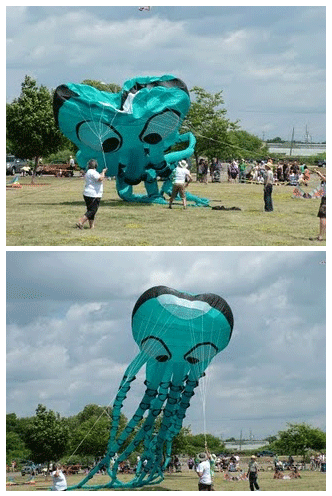 Saturday evening saw perfect kite winds from the south west off of Lake Erie. Clean and steady wind at 20 KPH. The ideal conditions allowed the kiters to fill the sky with two 100 kite trains by Jim and Barb Gibson (OSEK), four large Suttons [Suttons flying smoothly at a night fly? WoW!], Rokkakus, and every other imaginable kite form that kiters could pull from their collections. Simply put, it was awesome. A large crowd of spectators ringed the field and were totally appreciative of the spectacle. Spot and flood lights illuminated everything and there was a stellar backdrop of stars above it all. I can honestly say it was the best ever night fly at the Canal Days Kite Festival. I have been to a lot of night flys and can only remember one that ever matched it for spectacle. Thanks to Aeolus, the Greek God of wind, for providing the energy for the kites.
Saturday evening saw perfect kite winds from the south west off of Lake Erie. Clean and steady wind at 20 KPH. The ideal conditions allowed the kiters to fill the sky with two 100 kite trains by Jim and Barb Gibson (OSEK), four large Suttons [Suttons flying smoothly at a night fly? WoW!], Rokkakus, and every other imaginable kite form that kiters could pull from their collections. Simply put, it was awesome. A large crowd of spectators ringed the field and were totally appreciative of the spectacle. Spot and flood lights illuminated everything and there was a stellar backdrop of stars above it all. I can honestly say it was the best ever night fly at the Canal Days Kite Festival. I have been to a lot of night flys and can only remember one that ever matched it for spectacle. Thanks to Aeolus, the Greek God of wind, for providing the energy for the kites.
At 5:00 a.m. Sunday, a one hour downpour ensured that there would be some humidity later in the day. However, the strong winds helped to mitigate the heat a great deal. Again, blowing from the west and southwest there was plenty of motion to the air. Steady winds at 20 KPH in the morning accelerated to 28 KPH at ground level later in the afternoon. At elevation the winds were even stronger. Heavy duty kites and kite lines were in use everywhere. Six massive Suttons and line laundry blazed across the sky. Sprinkled in and around were many kites of all size and description.
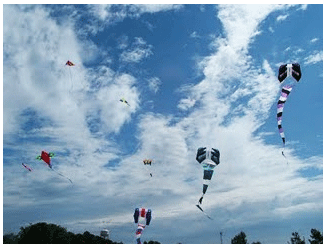 It was a day where the winds required kiters to use all of their skills to keep things up and safe. A relatively minor set of tangles and one line cut on a Power Sled were the only trouble spots of the day. The wind was directionally steady, but got bumpy as the speed increased in mid-afternoon, We had a terrific Grand Ascension and a welcome from Vance Badawey, Mayor of the City of Port Colborne who officially thanked all the visiting kiters for travelling to the event.
It was a day where the winds required kiters to use all of their skills to keep things up and safe. A relatively minor set of tangles and one line cut on a Power Sled were the only trouble spots of the day. The wind was directionally steady, but got bumpy as the speed increased in mid-afternoon, We had a terrific Grand Ascension and a welcome from Vance Badawey, Mayor of the City of Port Colborne who officially thanked all the visiting kiters for travelling to the event.
Revolution kite performances by Kerry St. Dennis, Bill Peart, Brendan Burge, Pete Rich, and Dru Nelissen showed the crowd what can be done with quad line kites. Ziggy Racek amazed everyone with his dual line expertise.
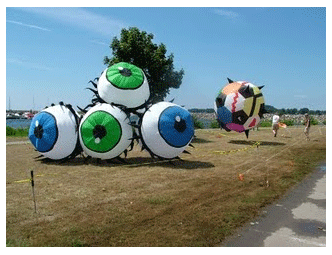 Stunning ground displays of flags, bouncers, spikey balls, fugus, large bols and two kite arches added colour to every point of view. The dancing eyeballs and a gaggle of welcoming ‘Penguins’ by Donna and Fred Taylor provided a photo-opportunity back drop for hundreds of kids and adults alike.
Stunning ground displays of flags, bouncers, spikey balls, fugus, large bols and two kite arches added colour to every point of view. The dancing eyeballs and a gaggle of welcoming ‘Penguins’ by Donna and Fred Taylor provided a photo-opportunity back drop for hundreds of kids and adults alike.
Following the flying, the Appreciation Barbeque was hosted in the Pavillion right on the field. Good food, and great fellowship made for a perfect wrap up to a very fine event. Special kite prizes included an amazing new Flare by kite-creating-masters Eric Curtiss and Anne Sloboda, a butterfly kite by Jacques Letourneau and Carlos Simoes, kite line donations by The Kite Studio, and kites from Blue Sky Kites in Oakville, ON made a lot of visitors happy. Fifteen special award plaks (cover of a 1938 magazine featuring kids with a kite) topped off the event.
View photos of the 2011 Canal Days Kite Festival.
Conyne Kites Used to Lift Radio Aerials to Assist Downed Seaplanes
During the early days of aviation the use of radio communication, also in its infancy, was dependent upon ideal conditions to get radio signals from the flying craft to land stations.
On August 27, 1910 Douglas McCurdy, flying an early Curtiss airplane, received what has been cited as the first wireless message sent to an aeroplane in flight, over Sheepshead Bay race track, New York1. Early wireless radio transmissions were of the Morse code variety adding to the complexity of the task of communicating between an airplane and the ground stations.
By 1917, the first air-to-ground and ground-to-air audio radio communications were accomplished by AT&T engineers working with the United States Army at Langley Field in Virginia. The experiments started on July 2nd and two way communication success was achieved by August 20, 1917.2
In all of the radio transmissions of this early era, lengthy aerials were trailed from the airplne in flight. These were spooled out after takeoff and wound in prior to landing. Later, by the early-1930's aerial wires were tautly strung from the fuselage behind the cockpit to the front of the rudder upright at the rear of the aircraft. Advances in wireless communication led to short mast aerials by late 1930.
During the 1920's seaplanes and 'flying boats'3 were often used for coastal patrols and other flights that took them over long stretches of water. Whenever a seaplane ran into engine trouble over water it could easily glide to a landing and very often there was no damage to the aircraft and no injury to the pilot and others aboard.
However, the prevalent radio communication of the day which employed the use of long trailing aerials was now useless with the seaplane on the surface of the water. This rendered radio communication impossible and left the downed pilots at the mercy of visual sightings by either search boats or rescue seaplanes.
To counter this loss of traditional radio contact by a downed seaplane, technical staff at the United States Navy Air Station Radio Laboratory in Anacostia D.C. came up with a pragmatic solution to the situation.
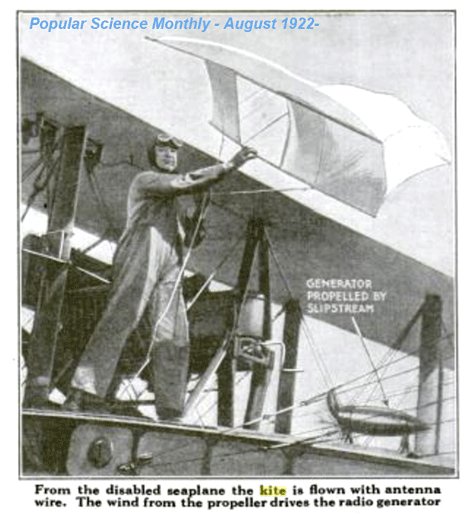 Commander Taylor and Lieutenant C.D. Palmer experimented with raising an antenna from the downed aircraft with a Conyne kite and attaching it to the seaplane's radio system. With the elevation of the kite to 200-300 feet using a light wire flying line which served as the aerial, they were able to establish radio communications over long distances.4
Commander Taylor and Lieutenant C.D. Palmer experimented with raising an antenna from the downed aircraft with a Conyne kite and attaching it to the seaplane's radio system. With the elevation of the kite to 200-300 feet using a light wire flying line which served as the aerial, they were able to establish radio communications over long distances.4
Simple kits, weighing only a few ponds, were developed for all seaplanes to equip them with these emergency aerials. In each kit were 350 feet or aerial wire/flying line and two kites. The largest kite was seven feet tall for light winds and a slightly smaller kite was six feet tall for stronger winds.
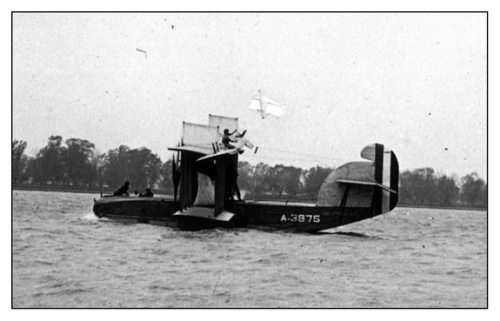
This use of kites to raise aerials when downed airmen were in distress was a precursor to the later Gibson Girl radio rescue system. Developed in 1932 in Great Britain, the Gibson Girl array used an aerial raised by a box kite. It was deployed throughout the Second World War and beyond.
The above uses of kites as rescue devices were not the only types of kite rescue systems. In 1859 an Irish priest, Fr. E.J. Corner designed a kite rescue system to lift sailors to safety from vessels wrecked along the rocky coast of Ireland.
Even today, kites are still carried by people on expeditions and at sea as a system for attracting attention and facilitating a rescue. The latest such system is the Skystreme radar reflective location marker kite available from Skystreme UK Ltd, Middlesex, UK. This kite is Airtight and waterproof and constructed of metallised Mylar laminate. Light in weight, the Skystreme kite flies, floats and can self launch in winds as light as 4 mph. Requiring no power supply of any description, it is able to lift devices such as compatible high visibilty strobe lights and windsocks.
______________________________
Notes:
1. Douglas McCurdy, one of the members of Alexander Graham Bell's Aerial Experiment Association, went on to work as a pilot for Curtiss Aircraft in 1910. Prior to that he had been the lead engineer on the Aerodrome #4 project, the Silver Dart, and the pilot of the first aircraft to fly in the British Empire (The Silver Dart, Feb. 23, 1909 at Baddeck, Cape Breton Island, Nova Scotia. McCurdy and a partner Casey Baldwin, also a member of the AEA, formed the Canadian Aerodrome Company in late 1909. When the Canadian government chose not to buy any of the early aircraft models produced by that company, McCurdy went to work for Glenn H. Curtiss at the Curtiss Aircraft Company in Hammondsport, NY.
2. AT&T - 1st Air-to-Ground / Ground-to-Air Radio Communication.
3. Airplanes using floats were first developed in the United States by Glenn H. Curtiss of the Aerial Experiment Association (the "Loon", September 1908) and by engineer Henri Fabre ("Le Canard" March 1910).
4. "Disabled Planes Send 'SOS' With Kite Antenna." Popular Science Monthly, August 1922, page 40.
5. Image of twin engine flying boat deploying Conyne kite with aerial. Source: US Naval Institue Archives.
Scots Soldiers Help Afghan Children Fill Skies With Kites
Scottish TV has reported that Scot soldiers on duty in Afghanistan have been handing out kites to the Afghan youth as a gift of friendship.
Kite flying is a well established cultural tradition in Afghanistan and the soldiers of the Second Battalion of the Royal Regiment of Scotland working near the Afghan village of Popalzai in the Lashkar Gah area of the country have gained popularity with the local youth through the gift of kites.
Reporter Cara Sulieman of stv writes that:
"Now they are concentrating on building relationships with the local community and have found the kites have gone down a storm.
Children in the area were not allowed to play with the popular toys when the insurgents ruled the village. With the help of soldiers from The Royal Highland Fusiliers, they are now building and flying the kites.
Colour Sergeant Roddy Weir said: “Before long the soldiers were sharing a laugh and a joke with the local children. The kids were thrilled to receive the kites and almost overwhelmed the soldiers who were showing them how to put them together.
“It was a strange experience for most of the young soldiers - it's not often you deploy on a foot patrol only to find yourself playing with kites and entertaining the local children.”
When on joint patrol, British and Afghan troops usually hand out notebooks, pens and Afghan flags as they build up links in the community.
The kite kits are a new addition to the presents and dozens were handed out on Wednesday.
Lieutenant Erik Smith added: “This was a fantastic sight and real evidence of progress in Helmand province."
The kites are not of the traditional Afghan kite variety but, nevertheless, they are a real hit with the youngsters.
Kite flyers all know the peaceful effects of kite flying as an expression of joy and appreciation of the outdoors, so it is no surprise that these gifts would have a positive effect on the young people of the area.
_________________
Photo source credit: http://www.stv.tv/ in the Feb. 3, 2011 story entitled: "Scots soliders hand out kites to Afghan Children".
Snowflake Kites Create the Mood in a Starbucks Holiday Commercial
To celebrate the 2010 Winter Holiday Season the Starbucks Corporation of Seattle, Washington created a visually impressive holiday commercial message using specially crafted, unique snowflake kites.
The commercial has received a good amount of air time on television and through viral messaging from social media sources. Although many will have seen this commercial, it deserves to be documented one more time along with the very interesting story behind the making of the one minute long video.
As any kiter knows, the placement of numerous kites in the sky for a special event is not just a random happening. There was a lot of work, planning, and skill that went into the creation of this visual promotion.
Conceived by the advertising firm of BBDO North America, a Madison Avenue agency, the project took on life through the cameras of the EPOCH Films of New York.
The critical element of flying the snowflake kites required the crack, expert kite team of dean jordan, Blake Pelton, Craig Wilson, Tim Elverston and Ruth Whiting to make all the exciting kite shots possible. The kites were created by dean, Blake, Mike Dennis, and Pam Kirk, along with some custom work from New Tech Kites.
dean was in New York for two weeks preparing for the shoot and carrying out the filming of the project. He spent a week location scouting, and then Blake arrived to do all of the technical scouting before doing the three days of shooting on the 18th, 19th, and 20th of October.
Again, kite fliers know that flying kites in downtown Manhattan or even in Liberty State Park, New Jersey, where some additional scenes were shot, is not an easy task. So, some movie magic was required to pull it all off.
Thanks to Blake Pelton and dean jordan, the making of the commercial was recorded and shared on YouTube. It is well worth while watching this video to see the work and the magic that went into the creation of the Starbucks commercial.
Once you watch the video on the making of the commercial, it is fun to return to the commercial to see how it all comes together for maximum visual effect and feeling.
Special appreciation goes to dean jordan, one of the true Jedi Knights of Kiting for providing me with details about the project.
For those of you interested in the terrific background music, it is entitled "Snow Day" by Matt Pond. The full version can be enjoyed, along with some of his unique song stylings on YouTube as well.
_____________________
Notes:
- Special thanks to Gary Mark of Blue Sky Kites for alerting me to this story and to dean jordan who generously posted on Facebook and provided me with details about his exploits in this project.
- The copyright for the commercial resides with Starbucks and the makers of the video. Generously shared via YouTube.com
- Music rights reside with the talented musician, Matt Pond.
- dean jordan (sic) will likely star at a major kite festival near you some time. His kites and personality on the field are always appreciated at any festival that he attends.




